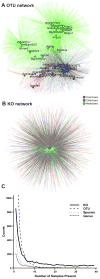Diet drives convergence in gut microbiome functions across mammalian phylogeny and within humans
- PMID: 21596990
- PMCID: PMC3303602
- DOI: 10.1126/science.1198719
Diet drives convergence in gut microbiome functions across mammalian phylogeny and within humans
Abstract
Coevolution of mammals and their gut microbiota has profoundly affected their radiation into myriad habitats. We used shotgun sequencing of microbial community DNA and targeted sequencing of bacterial 16S ribosomal RNA genes to gain an understanding of how microbial communities adapt to extremes of diet. We sampled fecal DNA from 33 mammalian species and 18 humans who kept detailed diet records, and we found that the adaptation of the microbiota to diet is similar across different mammalian lineages. Functional repertoires of microbiome genes, such as those encoding carbohydrate-active enzymes and proteases, can be predicted from bacterial species assemblages. These results illustrate the value of characterizing vertebrate gut microbiomes to understand host evolutionary histories at a supraorganismal level.
Figures



References
-
-
See supporting material on Science Online.
-
Publication types
MeSH terms
Substances
Grants and funding
LinkOut - more resources
Full Text Sources
Other Literature Sources
Medical
Molecular Biology Databases

